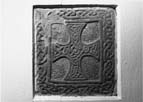Select a site alphabetically from the choices shown in the box below. Alternatively, browse sculptural examples using the Forward/Back buttons.
Chapters for this volume, along with copies of original in-text images, are available here.
Object type: Plaque [1]
Measurements: H. 44.2 cm (17.4 in) W. 41.2 cm (16.2 in) D. Built in
Stone type: Coarse-grained, feldspathic gritstone. Very pale brown (10YR 7/3). Typical of the Red Scar Grit (Millstone Grit, Namurian, Upper Carboniferous) which caps the Pennine Hills to the south of West Witton (i.e. Pen Hill).
Plate numbers in printed volume: Ill. 882
Corpus volume reference: Vol 6 p. 229-230
(There may be more views or larger images available for this item. Click on the thumbnail image to view.)
A broad decorative border of interlace runs round the rectangle, contained by narrow edge mouldings. The interlace is in narrow well-modelled strand, with alternate half-pattern D on all four sides. The design is irregular in places, particularly on the upper and lower right-hand corners, but the cutting is fine. The width of the border varies from 7.5 to 8.5 cm. The central rectangle formed by the inner moulding contains a low relief free-armed cross of type B9; the arms are equal. The arm-pits are widely curved and the arms splayed. The cross has a narrow perimeter moulding and is filled with fine modelled-strand interlace, whose pattern is bungled in three of the arms. The left-hand arm has a triquetra locking into the interlace. The background to the cross is dressed back with punch marks.
The function of this stone was either architectural or related to church furnishing. It might possibly be from the end of a composite box-shrine, though the more likely explanation may be that it belonged to a sculpted altar frontal, of the type represented at Ballavarkish, Isle of Man, and Flotta, Orkney (Thomas 1971, 184–9, figs. 89, 91). The absence of weathering suggests that it was indoors. The plaque Middleton 9, in Ryedale (Lang 1991, 187, ill. 694), is a contemporary parallel. Its location at West Witton, suggesting an early church, should be considered in relation to early sculpture at Wensley, two miles down the dale, where the cross-slabs are of a similar form (Ills. 883–6). It is interesting that fine measurement reveals a 1.7 cm unit of measure, equivalent to ⅔ inch: Insular metalwork often employed a ⅓ inch unit (Lang 1988, 98–100; Whitfield 1999).



